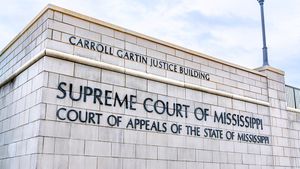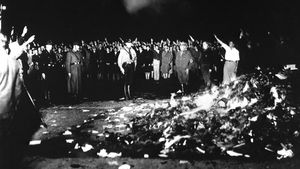Forty years ago this summer, the first news emerged about rare diseases that were killing gay and bisexual men. No one could know then that the events heralded a global pandemic, but fear was there in the early days — fear both of disease and of the stigma it would bring to an already marginalized population.
The story that made the biggest impression, although it wasn’t the first, was in The New York Times, considered the “paper of record” in the U.S. “Rare Cancer Seen in 41 Homosexuals,” the headline read in the article by Lawrence K. Altman, published July 3, 1981, on page 20 of the front section.
The rare cancer was Kaposi’s sarcoma, usually seen in people over 50, but these cases were in younger men, many of them under 40. They were sexually active gay and bi men, although the paper didn’t use the term “gay” at the time. The men often reported having multiple partners and using recreational drugs to enhance their sexual pleasure. And they were dying quickly — eight of them within 24 months of their KS diagnosis.
The same day Altman’s article came out, the Centers for Disease Control and Prevention published coverage of the outbreak in one of its newsletters, Morbidity and Mortality Weekly Report. A month earlier, the CDC newsletter had carried a story about another rare disease, pneumocystis pneumonia, or PCP, seen in five gay men in Los Angeles. The Los Angeles Times also reported on the pneumonia cases.
And in May the New York Native, a paper geared to the gay community, had run what’s recognized as the first article on what came to be known as AIDS, with its medical columnist, physician Larry Mass, reporting on the PCP cases.
The coverage was largely cautious. A CDC spokesman quoted by Altman downplayed the possibility of contagion, as the KS outbreak had been confined to gay men. A doctor with the New York City Department of Health told Mass that PCP wasn’t all that rare; a new and deadlier strain could be emerging, but no one knew. The L.A. Times story had a quote from Dr. Wayne Shandera of the CDC, though, that was sure to stoke fears of both disease and stigma: “The best we can say is that somehow the pneumonia appears to be related to gay life style.”
Reactions in the gay community were all over the map. “I think we were really terrified, especially at first,” says Charles Kaiser, a New York City-based journalist, author, and activist.
There were some who foresaw a pandemic, along with some who took comfort in the fact that the illnesses seemed to be concentrated in men with a large number of partners. And some definitely worried that, at a time when gay sex was still criminalized in many states and when few states or cities banned antigay discrimination, reports of a new disease found mostly in gay men could lead to further oppression, even quarantine concentration camps.
Mass recalls being both “very concerned and very cautious.” As a doctor and journalist, he didn’t want to jump to conclusions about the disease, but he understood the fears about the illness itself and the possibility that it could increase stigma. “This was a potentially dangerous situation,” he says. As the story of the new disease developed, he continued covering it, striving to be accurate but not alarmist, he notes.
Soon medical experts grouped the outbreaks under the umbrella of a syndrome they first called gay-related immune deficiency, but switched to the more neutral acquired immune deficiency syndrome, or AIDS, once it became clear the disease wasn’t confined to gay and bi men. Under either name, it was a deterioration of the body’s immune system that caused vulnerability to a variety of deadly infections. It wasn’t until 1984 that a recently discovered virus — the human immunodeficiency virus, or HIV — would be identified as the cause of AIDS.
Until the news about HIV, there were alternative theories about what caused AIDS; the predominant one in the gay community, Mass says, was that multiple factors were involved — a large number of sexual partners, drug use, poverty. But that didn’t really make sense for other groups, he notes.
To Mass, the greatest thinker of the AIDS epidemic is writer Larry Kramer, one of the men who joined Mass in founding Gay Men’s Health Crisis in 1982. Kramer believed the new disease was likely due to an infectious agent and “was the sort of Cassandra voice in saying this is really, really serious,” Mass says.
Kramer, who died last year, was highly critical of The New York Times’ coverage of the epidemic, as he was of the response by mainstream media in general, government, drug companies, and more. Kramer’s confrontational style was legendary and earned him some enemies, but it got public attention and led to breakthroughs in treatment and prevention. “Mostly, what Larry Kramer did was definitely on the right track,” Mass says.
Mass likewise doesn’t think much of the early Times reporting on AIDS or LGBTQ+ issues in general, saying the paper in that era “was hostile still to gays” and “very inadequate in its coverage.” Kaiser, however, describes himself as a “dissenter to the conventional wisdom that the Times did a bad job.” Altman, he says, was and is “an extremely serious, conscientious, and not homophobic reporter.” Both the media and gay activists were worried about creating a panic, Kaiser adds.
Altman, also a physician, is still working for the Times but was not available for an interview for this article. Previously, though, he has noted that the many unknown factors about what became known as AIDS posed a challenge to journalists. “Science news was running as fast and freely as Trump is today,” he said in 2018.
And in the 1980s, the U.S. had a conservative president, Ronald Reagan, whose response to AIDS — largely ignoring it — was as problematic in its own way as Donald Trump’s spreading of misinformation during the COVID-19 crisis. “The stupidity and bigotry and small-mindedness of the government cannot be overstated,” Mass says.
With 20/20 hindsight, it’s clear the press could have sounded a louder alarm, Kaiser notes. But no one could have predicted in 1981 that AIDS complications would take the lives of nearly 700,000 Americans and more than 30 million people worldwide.
To Mass, the greatest heroes of the AIDS story are Kramer and those who joined him in demanding action. “The gay community’s response to the AIDS epidemic under Larry Kramer was as glorious and heroic as anything in American history,” he says.
“There are things we all could have done better,” he adds, “but in the end things had to be done on the front lines. … There was a lot of heroism, a lot of good things done by a lot of good people.”














































































